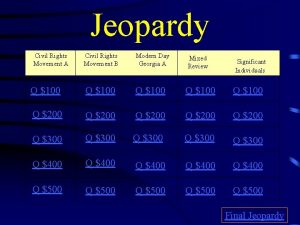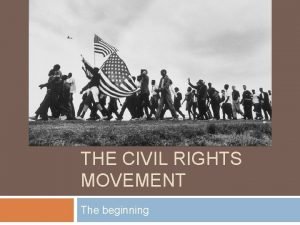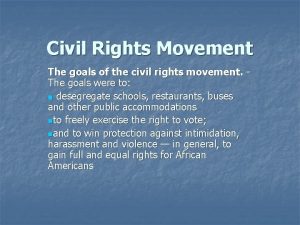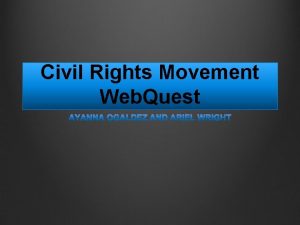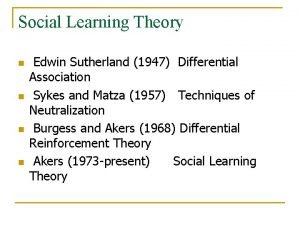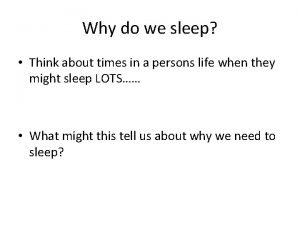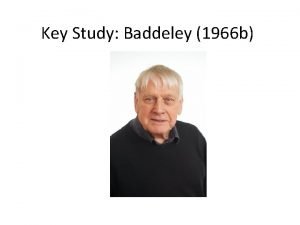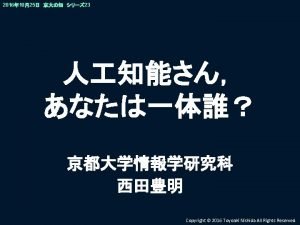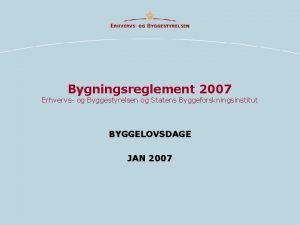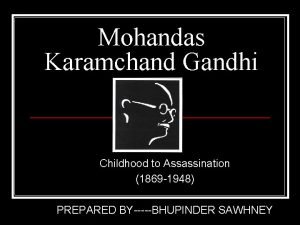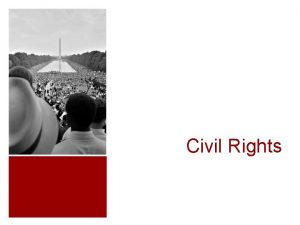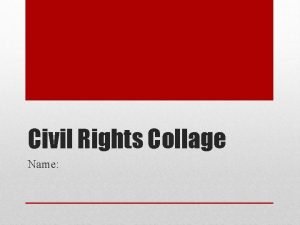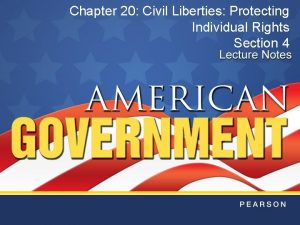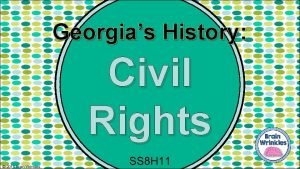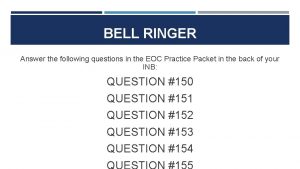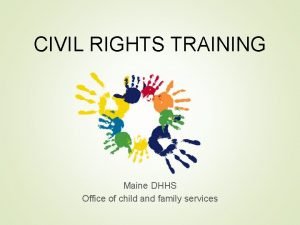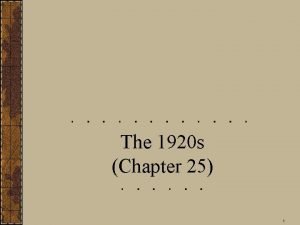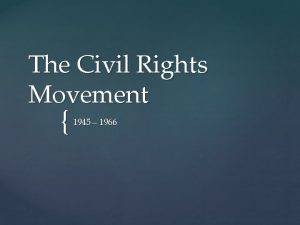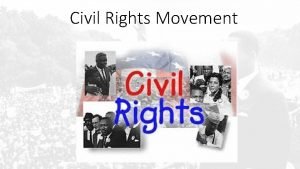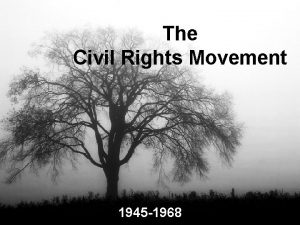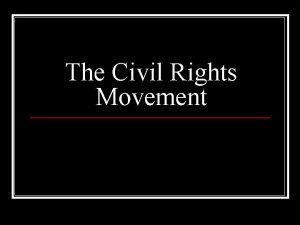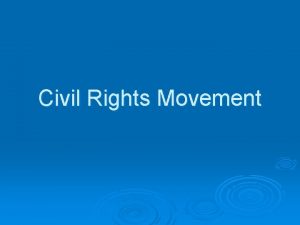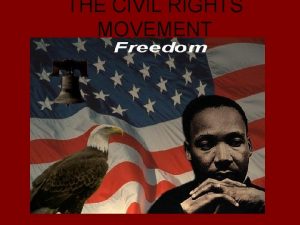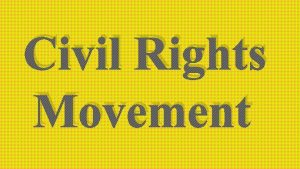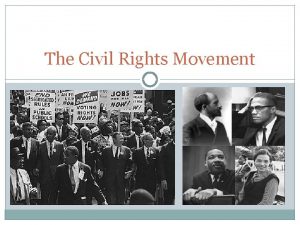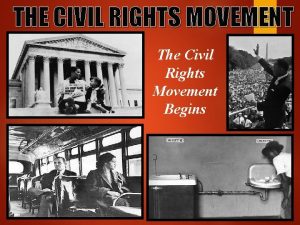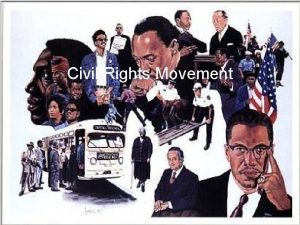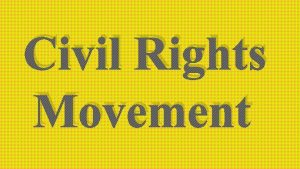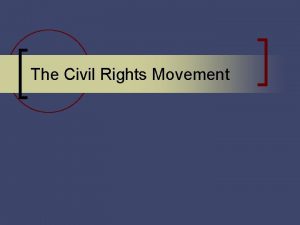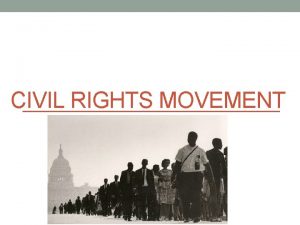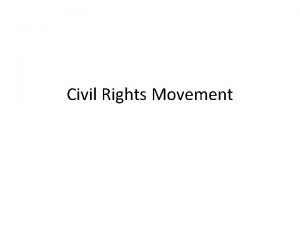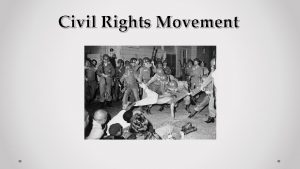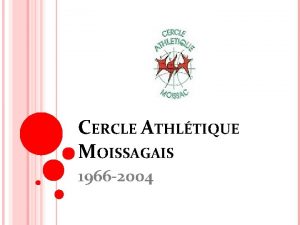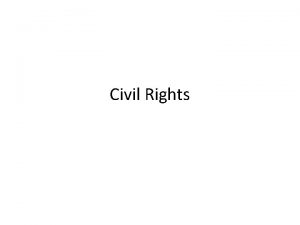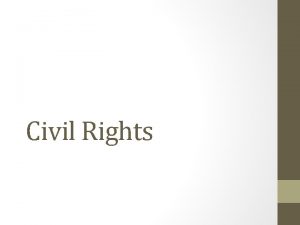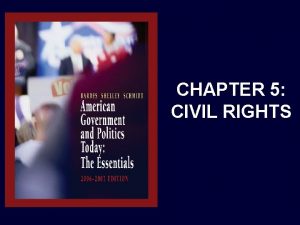The Civil Rights Movement 1945 1966 Civil rights




































- Slides: 36

The Civil Rights Movement { 1945 – 1966

Civil rights became a national issue for the first time since Reconstruction after the war The mass migration of African Americans to the North brought them political power and economic power, as they worked with unions and the Democratic machines of major cities The NAACP grew in numbers and its Legal Defense Fund initiated a series of lawsuits to win key rights (Morgan v. Virginia outlawed segregation on interstate busses) Jackie Robinson broke the color barrier in Major League Baseball in 1947 UN diplomat Ralph Bunche won the Nobel Peace Prize for arranging the Arab-Israeli truce of 1948 Musicians like Charlie Parker, Miles Davis, and Dizzy Gillespie revolted against the “white-washed” big band interpretations of jazz and created bebop, more complex, difficult to copy, and kept it exclusively to themselves Civil Rights After WWII

Parker (sax) and Davis (trumpet) trying to outdo one another in improv’d sessions designed for small groups that showed off each man’s style

Even in the late 1940 s, only 10% of African Americans in the South voted Jim Crow and other customs kept African Americans as second-class citizens with no effective political rights and most learned to survive by not challenging the situation The Segregated South


The NAACP initiated a series of court cases challenging the constitutionality of segregation with the intent of overturning Plessy Thurgood Marshall, special counsel for the NAACP, pushed hard to make segregation “too expensive” for the South to maintain with a series of lawsuits Newly appointed Chief Justice Earl Warren led the USSC to declare that separate educational facilities are inherently unequal (Brown)—a unanimous decision that overturned Plessy Though the court postponed the order for a year, it established a timetable to implement the decision; in Brown II (1955) it was declared that desegregation proceed “with all deliberate speed” Brown v. BOE (1954)

101 congressmen from southern states signed the Southern Manifesto that argued that Brown violated the Constitution, and urged southern states to resist desegregation Gov. Faubus of Arkansas defied the court order to begin integration by ordering the National Guard to keep African American children out of Central High School Eisenhower federalized the National Guard, sent in more troops and forced integration of the “Little Rock Nine” becoming the first president since Reconstruction to enforce civil rights Crisis in Little Rock (1957)




The Civil Rights Movement

1955: Montgomery, Alabama’s black community mobilized when Rosa Parks refused to give up her seat and comply with the law Led by a young Baptist minister, Martin Luther King, the bus boycott was launched A network of local activists organized carpools using private means to get to work Despite violence and legal harassment, the boycott worked and the segregation ordinance was declared unconstitutional Montgomery Bus Boycott

King emerged from Montgomery as a prominent national figure; King taught his followers nonviolent resistance modeled after Gandhi’s methods for India’s independence The Civil Rights movement was deeply rooted in the traditions of the African American churches and the Southern Christian Leadership Conference (SCLC) was founded to promote nonviolent direct action to challenge segregation Martin Luther King

The first sit-ins at Greensboro, NC were started by college students sitting at segregated lunch counters Nonviolent sit-ins were supported by the African American community and were accompanied by community-wide boycotts of business that would not integrate Sit-ins


A new spirit of militancy was evident among young civil rights activists 120 African American activists created the Student Nonviolent Coordinating Committee (SNCC) to promote nonviolent direct challenges to segregation and led nearly every battle for civil rights (direct confrontation, mass action, and civil disobedience) Idealistic young southern whites also joined to cause SNCC and the “Beloved Community”

The race issue was center-stage in 1960 Nixon strongly supported civil rights but minimized his own identification with it so as not to lose southern votes JFK took an active role in civil rights during the campaign, even pressuring an Atlanta judge to release King from jail JFK won 70% of the black vote Despite his victory, an unfriendly Congress and Cold War issue ensured that little civil rights legislation was to come out Attorney Gen. Robert Kennedy used the Justice Department to force compliance with desegregation orders The 1960 Election

Congress for Racial Equality (CORE) sponsored a freedom bus ride of biracial teams to ride interstate busses in the South The FBI and Justice Depts. knew of the plans but were absent when mobs firebombed a bus and beat the Riders No police protection at other stops only worsened the violence Kennedy was forced to mediate a safe conduct for Riders, though 300 of them were arrested for “inflaming public opinion” The Justice Department petitioned the ICC to end segregation on interstate busses (1962) The violence also indicated that the federal government was not fully committed to enforce these laws The Freedom Rides


Basically, where the federal government did not intervene, segregationists held their ground The Albany Movement was a coalition formed by SNCC, the NAACP, and other local groups in Albany, Georgia and they began their nonviolent resistance Over a thousand people spent time in jail including MLK, making Albany an national symbol of struggle, and eventual failure The integration of the University of Mississippi in 1962 by an air force veteran James Meredith required JFK to send 5, 000 troops to stop the rioting The failure at Albany and the “success” at U. Miss. Indicated that without direct federal support/action, Jim Crow could not be beaten The Albany Movement

In conjunction with the SCLC, local activists I Birmingham, Alabama planned a large desegregation campaign Public Safety Commissioner “Bull” Connor jailed 100 s of demonstrators, including MLK King’s Letter from a Birmingham Jail set out the issues at stake and criticized his denouncers: “Wait has almost always meant Never…and justice too long delayed is justice denied” Connor’s forces used water cannons, attack dogs and clubbed the demonstrators, many children, which was seen on national TV May 10: a settlement was negotiated to stop the demonstrations and desegregate businesses and public facilities Birmingham (May, 1963)

The shifting public consensus led JFK to appeal for civil rights legislation in a televised address on June 11, 1963 A. Philp Randolph’s old idea of a march on Washington was revived (remember WWII) The march presented a unified call for change and held up the dream of universal freedom and brotherhood (August 28, 1963) The event was climaxed by MLK’s famous “I Have a Dream” speech JFK and the March on Washington




JFK’s assassination on Nov. 23, 1963 threw a cloud over the movement as Lyndon Baines Johnson (LBJ) had never seemed an ally to civil rights LBJ saw civil rights as a way to unite the Democratic Party Using his political savviness, LBJ pushed the Civil Rights Act of 1964 through Congress that put a virtual end to Jim Crow, outlawing discrimination in public places, and employment LBJ and Civil Rights

In 1964, civil rights activists targeted Mississippi for a freedom summer that saw 900 volunteers going down to register black voters and fight segregation 2 white activists and a local black activist were quickly killed; LBJ sent the FBI down to investigate to little avail Tensions developed between white and black movement veterans The violence again attracted national attention and sympathy by northern liberals When the Mississippi Freedom Democratic Party was denied representation at the National Convention in 1964, and then a “compromised” two-seats, they turned it down, furthering African American disillusionment with the Democratic Party and liberals Freedom Summer

Many young African American activists were tired of the nonviolent “old ways” and the limited gains achieved thus far Many sought out Malcolm X who ridiculed integrationist goals, focusing on “separation; ” urged blacks to take pride in their African heritage; and break free of white domination After he broke with the Nation of Islam and made his pilgrimage to Mecca; in 1964 he returned with aims to seek common ground with the movement He was murdered on Feb. 21, 1965 His death pointed to a new black consciousness, soon to be known as Black Power Malcolm X and Black Consciousness


In Selma, Alabama, whites had kept blacks off the voting lists and brutally responded to protests March 7 (Bloody Sunday): marchers including MLK were attacked and beaten on the Pettus Bridge; the march was called off and MLK compromised to cross the bridge, pray and cross back (Further alienating him from the younger activists) White violence revived the movement as southern whites attacked white northern supporters LBJ addressed the nation and thoroughly identified himself with civil rights, declaring: “We Shall Overcome” and the march went forward August, 1965: LBJ singed the Voting Rights Act that authorized the federal supervision of voter registration in the South; it outlawed literacy tests and other forms of voter discrimination The 24 th Amendment had been ratified in 1964 outlawing poll taxes Selma (March, 1965)

Impact of Voting Rights Act of 1965

Mexican Americans formed groups to fight for their rights and also used the courts to challenge discrimination Legal and illegal Mexican migration increased dramatically during and after WWII; during the 1950 s efforts to round up undocumented immigrants led to a denial of basic civil rights and a distrust of whites In the 1960 s, La Raza emerged as the new movement promoting the shared ethnicity and historical experiences of the broader Mexican American community Mexican Americans and Immigrants

Although Puerto Ricans were US citizens, and had been forming communities since the 1920 s, they too faced cultural and economic discrimination By the 1960 s and 1970 s, the decline in manufacturing jobs and urban decay severely hurt their communities, forcing Puerto Ricans to focus on improving educational opportunities and pushing for bilingual education in schools Puerto Ricans

In 1952, the Immigration and Nationality Act removed the old ban on Japanese immigration and made first-generation Japanese Americans eligible for citizenship By 1965, over 46, 000 immigrant Japanese had taken oaths of citizenship Japanese Americans

During the 1954 -62, Congress passed 12 termination bills that ended tribal rights in return for cash payments and division of tribal assets Indian activists challenged government policies leading to court decisions that reasserted the principle of tribal sovereignty (US v. Wheeler, 1978) Reservation Indians remained trapped in poverty and alcoholism Indians who had located in cities lost connection with their tribes and focused more on civil rights rather than tribal rights Native Americans

Abolished all natural origin quotas and replaced them with overall “hemispheric” limits Asian immigration was the most profoundly affected as immigration increased ten-fold in about 30 years Immigration and Nationality Act of 1965
 Civil rights and civil liberties webquest
Civil rights and civil liberties webquest Civil rights movement jeopardy
Civil rights movement jeopardy The civil rights movement
The civil rights movement Civil rights movement goal
Civil rights movement goal Civil rights movement essential questions
Civil rights movement essential questions Civil rights movement vocabulary
Civil rights movement vocabulary Rosa parks mother
Rosa parks mother Civil rights movement webquest
Civil rights movement webquest Cabaret musical 1966
Cabaret musical 1966 Edwin sutherland theory
Edwin sutherland theory Gebranntes kind gedicht
Gebranntes kind gedicht Was invented by stephanie kwolek in 1966
Was invented by stephanie kwolek in 1966 Oswald 1966 restoration theory
Oswald 1966 restoration theory Pantglas school 1966
Pantglas school 1966 1967 1968 1969 1970 1971 1972 1973 1974 1975 1976
1967 1968 1969 1970 1971 1972 1973 1974 1975 1976 Fibra de vidrio 1966
Fibra de vidrio 1966 Bhore committee
Bhore committee Baddeley 1966
Baddeley 1966 Photo translate
Photo translate 1966-1998
1966-1998 Tar and cement
Tar and cement Irezumi (1966)
Irezumi (1966) Dr michael sternberg
Dr michael sternberg Bygningsreglement 1966
Bygningsreglement 1966 Processus décisionnel du consommateur
Processus décisionnel du consommateur Program of civil disobedience movement
Program of civil disobedience movement Civil right def
Civil right def Locomotor dance moves
Locomotor dance moves Light gun signals
Light gun signals Civil rights collage
Civil rights collage Montgomery bus boycott apush
Montgomery bus boycott apush Chapter 20 civil liberties protecting individual rights
Chapter 20 civil liberties protecting individual rights Cacfp civil rights
Cacfp civil rights Civil rights cloze notes 1
Civil rights cloze notes 1 Civil rights bell ringers
Civil rights bell ringers Civil rights training certificate
Civil rights training certificate Chapter 14 postwar prosperity and civil rights
Chapter 14 postwar prosperity and civil rights

